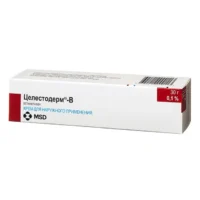Description
Flucinar (Fluocinolon) Gel 0.025% 15 g
Ingredients
Active ingredient: Fluocinolone acetonide 0.025% w/w. Other ingredients: propylene glycol, carbomer, sodium hydroxide, and purified water.
Mechanism of Action
Fluocinolone acetonide, a potent corticosteroid, exerts anti-inflammatory, antipruritic, and vasoconstrictive effects on the skin by inhibiting the release of inflammatory mediators and suppressing immune responses in corticosteroid-responsive dermatoses.
Pharmacological Properties
Fluocinolone acetonide in Flucinar gel acts by penetrating the skin layers and interacting with inflammatory pathways, thereby reducing inflammation, itching, and associated symptoms in various dermatoses.
Indications for Use
Flucinar gel is indicated for the relief of inflammatory and pruritic manifestations of corticosteroid-responsive dermatoses, including eczema, psoriasis, and dermatitis.
Contraindications
Do not use Flucinar gel if you are allergic to fluocinolone acetonide or any other ingredients in the product. Avoid application on the face, groin, or underarms without healthcare provider guidance.
Side Effects
Potential side effects of Flucinar gel may include skin thinning, discoloration, and local irritation. Prolonged use or inappropriate application may increase the risk of adverse reactions.
Usage Instructions
Dosage: Apply a thin layer of Flucinar gel to the affected area 2-3 times daily. Avoid covering with bandages unless advised by a healthcare provider. Clean and dry the area before application and wash hands after use.
Benefits Compared to Analogues
Flucinar gel offers targeted relief by directly addressing inflammation and itching, with a lower risk of systemic side effects compared to other topical corticosteroids. Its limited skin absorption makes it suitable for long-term management of chronic dermatoses.
Suitable Patient Groups
Flucinar gel is suitable for adults, including the elderly, for the management of corticosteroid-responsive dermatoses. Consult a healthcare provider for appropriate use in children or individuals with specific medical conditions.
Storage and Shelf Life
Store Flucinar gel at room temperature, away from direct sunlight and moisture. Check the expiration date on the packaging and do not use the product beyond the stated shelf life.
Packaging Description
Flucinar gel is available in a 15 g tube for topical application. The packaging includes instructions for use, dosage guidance, and a complete list of ingredients.
Clinical Evidence and Proven Effectiveness
Studies have demonstrated the efficacy of fluocinolone acetonide in reducing inflammation and itching associated with dermatoses. Research published in the Journal of the American Academy of Dermatology supports the use of fluocinolone acetonide in eczema and psoriasis treatment.





